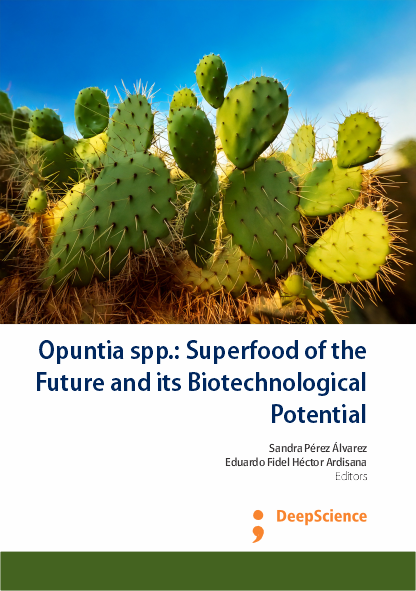Morphological description of Opuntia spp.: Generalities
Synopsis
The genus Opuntia, which is endemic to the American continent and groups together 181 species, according to Anderson (2002) up to 215 (Hunt, 2002), of which 76 are wild and are found in Mexico, mainly in arid areas (Guzmán et al., 2003), being grouped into 17 series (Bravo, 1978). This genus is part of the Cactaceae family (Shetty et al., 2012) grouping the most abundant dicotyledonous angiosperm plants in semiarid and arid areas, and around 130 genera, in the order Caryophyllales (Khan et al., 2024; Hernández-Ledesma et al., 2015).
The most important species cultivated in Mexico are Opuntia ficus-indica, O. joconostle, O. megacantha and O. streptacantha. Additionally, O. robusta, O. leucotricha, O. hyptiacantha and O. chaveña are harvested from wild populations of prickly pear cactus in semi-arid areas with poor soils, which cover almost 3 million hectares of the states of Chihuahua, Baja California Norte and Sur, Querétaro, Zacatecas, Coahuila, Sonora, Sinaloa, Jalisco, Nuevo León, Durango, Hidalgo, Tamaulipas, San Luis Potosí, and Guanajuato (Ochoa & Barbera, 2018).
Opuntia ficus-indica (L.) Mill. is the Opuntia species most widely cultivated, which is distinguished by its fruit with a sweet and juicy pulp of various colors, like purple or red, orange, green-white, and yellow. The pulp content in the fruit varies from variety to variety and usually has a very thin peel. The colored varieties have two uses: the production of natural pigments (betalains) and the connected health effects derived from the antioxidants present in them (Azeredo, 2009).
The most common applications of Opuntia plants are animal feed (forage crop), shelter and food for wildlife, erosion regulation and soil restoration, especially in arid and semi-arid areas (Le Houérou, 2002). In addition, the fleshy stems and fruits (nopales), are considered as food; fresh fruits can be eaten as they are, dehydrated, or used in jams. Meanwhile, the term “nopal” is commonly associated with the fresh fruit, but it is more frequently consumed by Mexicans in salads (Díaz-Medina et al., 2007). This crop can also be used in medicine (Giglio et al., 2020; Almalki et al., 2019), cosmetology (Gharby et al., 2021; Damasceno et al., 2016), and agro-energy for obtaining methane and biogas (Espinosa-Solares et al., 2022).
The use of prickly pear (Opuntia spp.) as fodder is based on the use of wild varieties. However, in Morocco, Tunisia, Brazil, and South Africa, it is cultivated in specific plantations; its leaves and fruits have multiple purposes, such as food, or are ultimately processed industrially. This is possible thanks to its natural ability to provide water and energy, especially during dry seasons (Veleta-Cruz et al., 2024).
It is imperative to recognize the connection between their growth, fruit, and nutritional value. Regarding cladodes, it is detected that the protein and water content is higher in young leaves or shoots than in stalks, so at that age they are best used for forage. Furthermore, the amount of fiber increases as the plant ages, being higher in stalks than in shoots (Muñoz-Guevara et al., 2024).
Among the species cultivated for fodder, some stand out, such as O. ficus indica, O. robusta, and O. durangensis. The most commonly used varieties for animal feed are O. phaeacantha, O. robusta, O. lindheimeri, O. rastrera, and O. cantabrigiensis. Prickly pear cactus is considered efficient as animal feed, due to its potential to transform water into dry matter, turning it into a digestible energy source. This usefulness is not recent; species of the Opuntia genus have been essential in meeting the need for fodder in semi-arid regions over time (Torres-Ponce et al., 2015).














